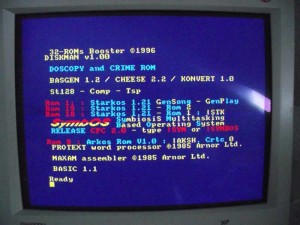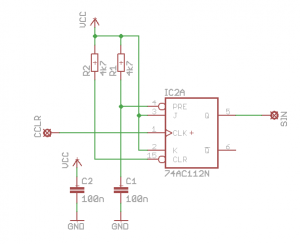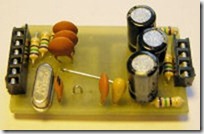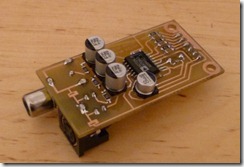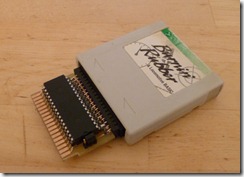During the last years I searched for a good method to connect my Amstrad CPC to a VGA display, but haven’t found the desired hardware to do that. During a search on e*ay I found a converter, which was designed for arcade machines, and connected it to my CPC. You can now find the result and more information of that in the “Articles” section.
Nilquader and I decided to release our Verilog code (based on Nocash’s decryption of the algorithm) to “emulate” the ACID protection chip of the Amstrad Plus. So, you can now find it in the [[Amstrad Cartridge Identification Device|ACID article]] of the CPCWiki and right here in this posting:
`timescale 1ns / 1ps
//////////////////////////////////////////////////////////////////////////////////
// Company:
// Engineer: Octoate, Nilquader
// ACID Reverse engineering by nocash
//
// Create Date : 00:45:53 09/03/2010
// Design Name : amsacid
// Module Name : amsacid
// Project Name :
// Target Devices: Xilinx XC9572
// Tool versions :
// Description : Reverse engineered Amstrad 40908 "ACID" Chip
//
// Revision:
// Revision 0.05
// Additional Comments:
//
//////////////////////////////////////////////////////////////////////////////////
module amsacid(PinCLK, PinA, PinOE, PinCCLR, PinSIN);
input PinCLK;
input [7:0]PinA;
input PinOE;
input PinCCLR;
output [7:0]PinSIN;
wire PinCLK;
reg [16:0]ShiftReg = 17'h1FFFF;
wire [16:0]CmpVal;
wire [16:0]XorVal;
assign CmpVal = 17'h13596 ^ (PinA[0] ? 17'h0000c : 0)
^ (PinA[1] ? 17'h06000 : 0)
^ (PinA[2] ? 17'h000c0 : 0)
^ (PinA[3] ? 17'h00030 : 0)
^ (PinA[4] ? 17'h18000 : 0)
^ (PinA[5] ? 17'h00003 : 0)
^ (PinA[6] ? 17'h00600 : 0)
^ (PinA[7] ? 17'h01800 : 0);
assign XorVal = 17'h0C820 ^ (PinA[0] ? 17'h00004 : 0)
^ (PinA[1] ? 17'h06000 : 0)
^ (PinA[2] ? 17'h00080 : 0)
^ (PinA[3] ? 17'h00020 : 0)
^ (PinA[4] ? 17'h08000 : 0)
^ (PinA[5] ? 17'h00000 : 0)
^ (PinA[6] ? 17'h00000 : 0)
^ (PinA[7] ? 17'h00800 : 0);
always@(negedge PinCLK)
begin
if (PinCCLR) // not in reset state
begin
if (!PinOE && ((ShiftReg | 17'h00100) == CmpVal))
begin
ShiftReg <= (ShiftReg ^ XorVal) >> 1;
ShiftReg[16] <= ShiftReg[0] ^ ShiftReg[9] ^ ShiftReg[12] ^ ShiftReg[16] ^ XorVal[0]; // hier xorval mit berüchsichtigen
end
else
begin
ShiftReg <= ShiftReg >> 1;
ShiftReg[16] <= ShiftReg[0] ^ ShiftReg[9] ^ ShiftReg[12] ^ ShiftReg[16];
end
end
else
begin
ShiftReg <= 17'h1FFFF;
end
end
//assign PinSIN = ShiftReg[7:0] ^ 8'hff;
assign PinSIN = ShiftReg[7:0];
//assign PinSIN[0] = PinCLK;
endmodule
But this isn’t everything about the ACID. We also found a timing problem during the investigation with a logic analyzer, which you can see here:
You will find glitches on the /CCLR line which show that the SIN contact should be changed… All in all it is possible to use a fast flip-flop to change the SIN signal when such a glitch occurs (see picture below).
You see, this is a very simple schematic, but it isn’t much cheaper than a CPLD, which emulates the full ACID and it comes with a disadvantage: it won’t work with a reset, so you always have to switch the CPC off and on again.
So, have fun with it – maybe Bryce will change his cartridge design and support this solution in the future :-).
Thanks to an tweet by Dadman I saw that he updated his blog about an ACID replacement. If I understand it correctly (I had to use a translator, because my spanish isn’t good enough), mcleod_ideafix has also finished the ACID emulation for the Amstrad Plus. So we will surely see new hardware for the Plus coming ![]() . You will find more information about it on http://www.zxprojects.com.
. You will find more information about it on http://www.zxprojects.com.
Nilquader and I wrote a ACID emulation about half a year ago on the XzentriX 2010 meeting, but we decided not to release the code until a new hardware is ready, because we wouldn’t like to see high-priced bootlegs on e*ay…
[UPDATE:] Because the release of the ACID emulation code, Nilquader and I decided to release our ACID emulation code, too. You can find the source of it here.
Bryce, already known for his great hardware extensions for the CPC, released a new hardware design which converts the RGB signal output of the CPC to a SVideo signal. It consists only of a few hardware components and is very cheap to build. Because some users requested it to be as small as possible to integrate the circuit into their CPCs, Bryce designed it to be as small as possible. You can get the schematics, the board layout and a more detailed description in the “[[RGB SVideo]]” article in the CPCWiki. You can discuss the hardware here.
Bryce announced the MITM (man-in-the-middle) cartridge adapter, which sits between a Plus cartridge and the Plus. With this adapter, you just need an original cartridge with an ACID protection chip which is directly connected to the CPC, but it will read the contents of the EPROM on the adapter. Maybe you know the same principle from playing Super Nintendo games from foreign countries – they used such an adapter to bypass the protection chip, too.
You can find an [[MITM|article about the adapter]] in the CPC Wiki. The schematics and layout will follow soon.

